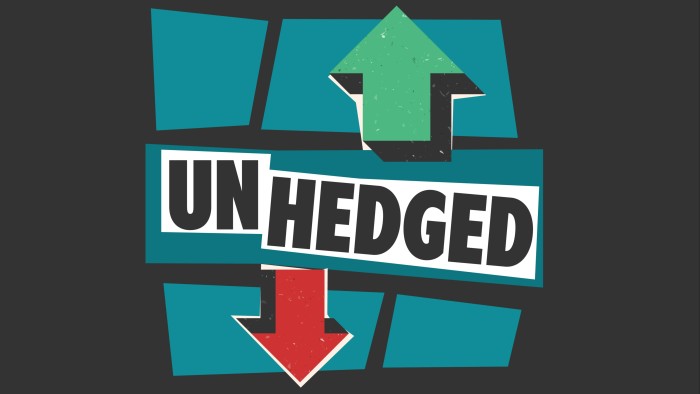This article is an on-site version of our Unhedged newsletter. Premium subscribers can sign up here to get the newsletter delivered every weekday. Standard subscribers can upgrade to Premium here, or explore all FT newsletters
Good morning. American industrial giant Honeywell, under pressure from the activist investor Elliott, has announced plans to separate its aerospace division, spin off its advanced materials arm and divest itself of smaller business lines. The stock fell 6 per cent on the news. Did Elliott remember to double check its sum-of-parts model? Email us about your worst Excel errors: [email protected] and [email protected].
Michael Pettis on rebalancing trade
Michael Pettis has been having a moment. His theories of trade imbalances and capital flows have garnered support among Democrats and Republicans, and have served as the intellectual justification for President Donald Trump’s tariff policies. Economic commentators Paul Krugman, Noah Smith and Tyler Cowen have recently published pieces strongly criticising his work. We decided to pose their critiques to him and let him respond in his own words.
Krugman and Smith argue that tariffs tend to strengthen the dollar, making imports cheaper and neutralising the tariffs’ effect on the balance of trade. What is your response?
Pettis: I agree with their analysis, but I want to point out important implications that are often overlooked in the broader discussion on trade imbalances in the US. Tariffs, as noted by Harvard economist Dani Rodrik, are effectively “a specific combination of two different policies: a tax on consumption of the imported good and a production subsidy for its domestic supply”. In essence, tariffs work much like currency devaluation, which can have both expansionary and deflationary effects depending on the circumstances.
The underlying conditions matter, in other words. While tariffs are not a cure-all, they should not be dismissed. Instead, tariffs are part of a broader industrial policy aimed at addressing trade imbalances by redistributing income between different groups, both at home and abroad.
In fact, given the singular role the US plays in absorbing global savings imbalances, tariffs are not an especially useful tool with which to combat US trade imbalances. As long as there are large economies that implement mercantilist trade and industrial policies that allow them to subsidise manufacturing production at the expense of domestic demand, they must run trade surpluses to balance the gap. And as long as they export their excess savings to the US, the US must run the corresponding deficit and run the inverse policies. This means that through an overvalued currency, or any of a number of mechanisms, the US economy effectively subsidises consumption at the expense of manufacturing production.
This dynamic implies that tariffs alone are unlikely to address the fundamental issue of trade imbalances. Instead, US policy must be directed at changing global trade and savings imbalances or, more specifically, preventing these imbalances from being absorbed by the US. This brings me to two conclusions that some may find surprising: first, that bilateral tariffs are largely ineffective in adjusting trade imbalances, and second, that tariffs on deficit countries — like Canada, Mexico and Colombia — can actually worsen US trade imbalances.
Cowen argues that intervention in the short term, as you have proposed, is counterproductive because demand shortfalls will resolve themselves as price adjustments. What is your response?
Pettis: While I understand Cowen’s reliance on the “Econ 101” model, which assumes that prices always adjust to balance supply and demand, this framework isn’t relevant in the context of current global economic conditions. Prices have not adjusted in the US or many other countries over several decades. Take China as an example, where price deflation has persisted and consumption has remained exceedingly low for years. To manage the gap between production and consumption, China has had to resort to extraordinarily high levels of investment and, as the cost of this wasteful investment has recently shown up in the form of the fastest- growing debt burden in history, to the highest trade surpluses in history.
So why hasn’t the demand shortfall “gone away”, as Cowen’s model would predict? The answer lies in China’s trade and industrial policies, which enhance global manufacturing competitiveness at the expense of domestic consumption. These policies include an undervalued currency, repressed interest rates, highly directed credit, and, yes, tariffs. These policies, together with strict controls on trade and even stricter controls on the capital account, have prevented any natural adjustment from taking place. This matters, because a country’s internal imbalances created by domestic policies lead automatically to its external imbalances which, in turn, must be reflected in the external imbalances of the trade and investment partners of that country. That is how internal policies in one country will lead automatically to changes in the internal conditions in other countries.
Cowen’s models may well be internally consistent, but they are based on simplified assumptions that clearly fail to describe the real-world factors that shape trade imbalances.
Smith and Krugman state that US manufacturing is heavily dependant on intermediate goods, sourced from trade partners now being threatened with tariffs. Reliance on foreign parts will make it difficult for US manufacturers to shift the trade deficit, they argue, and raise prices for all US goods if tariffs are put in place. Do you agree? How should we think about intermediate goods?
Pettis: While I understand this concern, I believe the focus should be on trade adjustments as a systemic issue rather than an incremental one. I would argue that tariffs and other trade policies work primarily through income effects rather than price effects. The key objective of US trade policy, in that case, should be to facilitate a transfer of income from household consumers to local producers. If this is done successfully, the resulting growth in production will drive an increase in consumption and better living standards. While tariffs on intermediate goods may be less efficient than tariffs on consumer goods, the overall income effect is what matters most in addressing trade imbalances.
Cowen argues that what you characterise as “weak American demand” does not align with the US economy’s high consumption and recent inflationary increase. Could you provide more detail on what you mean when you have written “investment in the US is constrained by weak demand, not scarcity of capital”?
Pettis: According to Cowen, and many mainstream American economists, foreign capital is always “pulled” into the US by the needs of US investment. They argue that because Americans save too little to meet the investment needs of US businesses, the US must import foreign capital. A country’s current account deficit, after all, is equal to its net capital inflows, which are equal to the shortfall between domestic investment and domestic savings. The US invests more than it saves, according to this argument, so therefore it must import foreign capital to bridge the gap.
But while this may have been true in the 19th century when the US relied heavily on European capital for domestic investment, it is not the case today. Contrary to Cowen’s claim, US business investment is not constrained by a lack of American savings. Just look at what US businesses say. They argue that if they are not investing in increased manufacturing, it is more likely because they do not believe they can produce profitably in the face of intense global competition, particularly from countries like China, Germany, South Korea and Taiwan, whose trade surpluses reflect a competitive advantage achieved at the expense of weak domestic demand.
Another way to assess this is by looking at what businesses do with retained earnings. If US companies were eager to invest domestically but constrained by a lack of savings, they would not be sitting on massive cash reserves or spending heavily on share buybacks and dividend payments. This suggests that the problem is not a shortage of capital but a lack of profitable investment opportunities in the US.
Moreover, the inflow of foreign savings into the US economy has broader implications for trade imbalances. When countries with mercantilist policies run trade surpluses and invest their excess savings in US financial markets, US investment must exceed US savings, even if it is not driven by rising US business investment. If this increase in investment is driven by foreign investment inflows, these inflows must be matched by a fall in US savings. This concept, though difficult for many American economists to accept, follows directly from the rules and standards of accounting.
The US is running persistent and significant trade imbalances that undermine its global manufacturing share, worsen income inequality and increase debt. While some of these imbalances are due to domestic factors, many are driven by external factors, which in turn exacerbate domestic imbalances. The goal of US trade and industrial policy should be to address these imbalances, both domestically and internationally.
Clarification on renminbi
When discussing the renminbi yesterday, we said that the People’s Bank of China “weakening the currency and pushing the economy closer to deflation could cause worse harm than the tariffs”. Many readers have pointed out that a currency weakening is inflationary — not deflationary. That is absolutely correct. The point we were trying to make was that a weaker currency would weigh on already low consumer sentiment and investment, with long-term deflationary implications. We apologise for not being clearer.
One good read
Brain drain.
FT Unhedged podcast

Can’t get enough of Unhedged? Listen to our new podcast, for a 15-minute dive into the latest markets news and financial headlines, twice a week. Catch up on past editions of the newsletter here.
Recommended newsletters for you
Due Diligence — Top stories from the world of corporate finance. Sign up here
Free Lunch — Your guide to the global economic policy debate. Sign up here
https://www.ft.com/content/a0d067ab-ab94-4c2f-bda3-bbac191fe652


